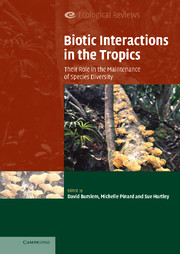Book contents
- Frontmatter
- Contents
- List of contributors
- Preface
- PART I Plant–plant interactions
- PART II Plant–microbe interactions
- PART III Plant–animal interactions
- 10 Implications of plant spatial distribution for pollination and seed production
- 11 Seed dispersal of woody plants in tropical forests: concepts, examples and future directions
- 12 The role of trophic interactions in community initiation, maintenance and degradation
- 13 Impacts of herbivores on tropical plant diversity
- 14 Have the impacts of insect herbivores on the growth of tropical tree seedlings been underestimated?
- 15 Multi-trophic interactions and biodiversity: beetles, ants, caterpillars and plants
- 16 The trophic structure of tropical ant–plant–herbivore interactions: community consequences and coevolutionary dynamics
- 17 Multitrophic interactions in a neotropical savanna: ant–hemipteran systems, associated insect herbivores and a host plant
- PART IV Biotic interactions in human-dominated landscapes
- Index
- References
15 - Multi-trophic interactions and biodiversity: beetles, ants, caterpillars and plants
Published online by Cambridge University Press: 25 August 2009
- Frontmatter
- Contents
- List of contributors
- Preface
- PART I Plant–plant interactions
- PART II Plant–microbe interactions
- PART III Plant–animal interactions
- 10 Implications of plant spatial distribution for pollination and seed production
- 11 Seed dispersal of woody plants in tropical forests: concepts, examples and future directions
- 12 The role of trophic interactions in community initiation, maintenance and degradation
- 13 Impacts of herbivores on tropical plant diversity
- 14 Have the impacts of insect herbivores on the growth of tropical tree seedlings been underestimated?
- 15 Multi-trophic interactions and biodiversity: beetles, ants, caterpillars and plants
- 16 The trophic structure of tropical ant–plant–herbivore interactions: community consequences and coevolutionary dynamics
- 17 Multitrophic interactions in a neotropical savanna: ant–hemipteran systems, associated insect herbivores and a host plant
- PART IV Biotic interactions in human-dominated landscapes
- Index
- References
Summary
Biodiversity as a process
Biodiversity is dynamic, with species richness and composition changing over time and space in response to ecological, evolutionary and physical processes (e.g. Todd et al. 2002; Prieto et al. 2001; Hart et al. 1989; Menge et al. 1983). The scale of changes in biodiversity can be large, such as changes in geological time from plate tectonics (e.g. Crame 2001), variable, such as expected from global climate change, or as small as those responding to localized disturbance or heterogeneity (e.g. Clark et al. 1982; Louton et al. 1996; Jansen 1997). At each of these scales, biodiversity can be conceptualized as a process responsive to particular biotic and abiotic factors rather than as a static attribute of a particular location. The role of biotic interactions in maintaining biodiversity in tropical ecosystems, then, can be elucidated by studies that show how biotic factors can singly or in combination, directly or indirectly, change biological diversity in those systems. Using a model system in Costa Rica we will highlight indirect trophic interactions that cause changes in biodiversity within a rainforest food web.
Whereas theoretical studies in ecology and evolution are often on the mark with respect to their appreciation of dynamic processes, their application in efforts to conserve biodiversity has been subject to shortcuts. Specifically, over the last century, many conservation efforts have focused on saving particular species at certain locations. Broader goals now target particular habitats and hotspots of endemism.
- Type
- Chapter
- Information
- Biotic Interactions in the TropicsTheir Role in the Maintenance of Species Diversity, pp. 366 - 385Publisher: Cambridge University PressPrint publication year: 2005
References
- 3
- Cited by



